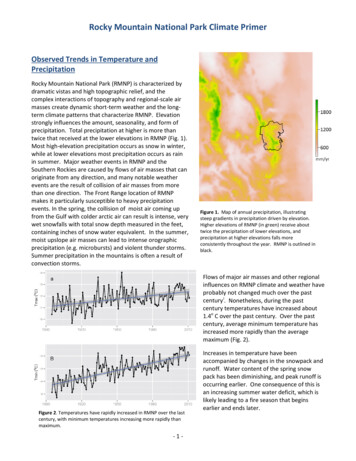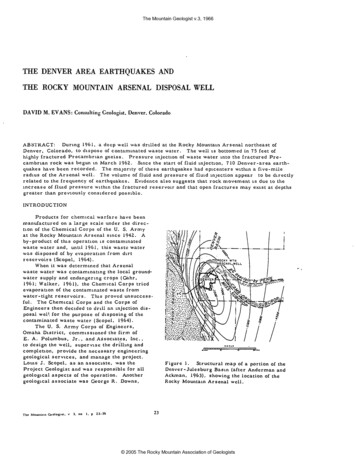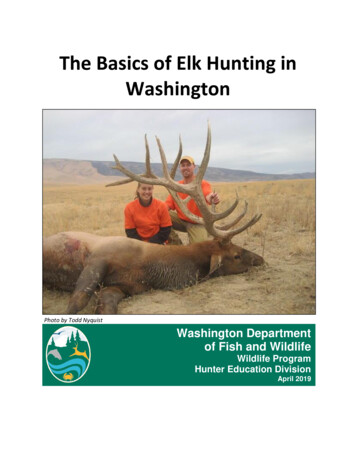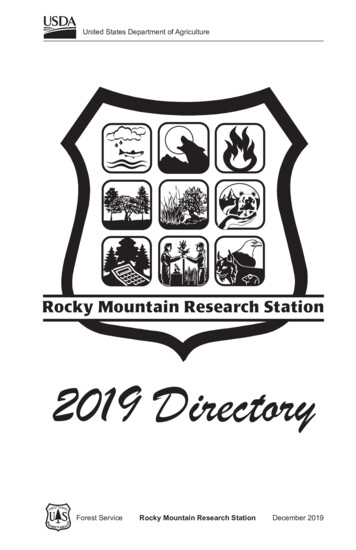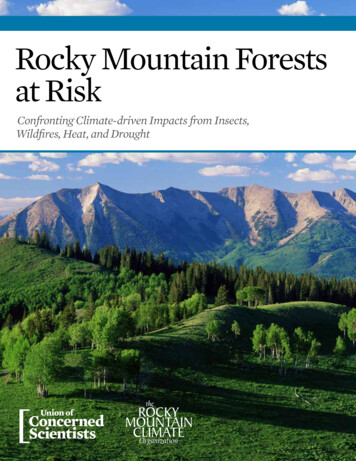
Transcription
Rocky Mountain Forestsat RiskConfronting Climate-driven Impacts from Insects,Wildfires, Heat, and Drought
Rocky Mountain Forestsat RiskConfronting Climate-driven Impacts from Insects, Wildfires,Heat, and DroughtLead authorsJason FunkStephen SaundersContributorsTodd SanfordTom EasleyAdam MarkhamSeptember 2014
September 2014Union of Concerned Scientists and theRocky Mountain Climate OrganizationAll rights reservedCitation:Funk, J., S. Saunders, T. Sanford, T.Easley, and A. Markham. 2014. RockyMountain forests at risk: Confrontingclimate-driven impacts from insects,wildfires, heat, and drought. Report fromthe Union of Concerned Scientists and theRocky Mountain Climate Organization.Cambridge, MA: Union of ConcernedScientists.Jason Funk is a senior climate scientistat the Union of Concerned Scientists. Heis a former land-use and climate scientistat the Environmental Defense Fund,and is certified as an expert reviewer forland-use emissions inventories under theUnited Nations Framework Convention onClimate Change.Stephen Saunders is president andfounder of the Rocky Mountain ClimateOrganization. He served in the Clintonadministration as deputy assistantsecretary of the U.S. Department of theInterior over the National Park Serviceand the U.S. Fish and Wildlife Service.The Union of Concerned Scientists putsrigorous, independent science to work tosolve our planet’s most pressing problems.Joining with citizens across the country,we combine technical analysis andeffective advocacy to create innovative,practical solutions for a healthy, safe, andsustainable future.The Rocky Mountain ClimateOrganization works to reduce climatedisruption and its impacts, to help keepthe interior West the special place that wecherish. We do this in part by spreadingthe word about what a disrupted climatecan do to us and what we can do about it.More information about the Union ofConcerned Scientists (www.ucsusa.org) andthe Rocky Mountain Climate Organization(www.rockymountainclimate.org) can befound online.This report is available online at www.ucsusa.org/forestsatrisk and www.rockymountainclimate.org/reports 6.htm.Cover photo: John FielderAn unprecedented combination of tree-killinginsects, wildfire, and heat and dryness is alreadyseverely affecting key trees across six states,jeopardizing the beauty and integrity of forests likethis in Colorado’s West Elk Wilderness.Todd Sanford is an independentconsultant and formerly a climate scientistwith the Union of Concerned Scientists.His current work focuses on climateimpacts in the western United States.Tom Easley is director of programs at theRocky Mountain Climate Organization.He is the former director of statewideprograms for Colorado State Parks.Adam Markham is the director of theClimate Impacts Initiative at the Unionof Concerned Scientists. He has morethan 20 years of experience workingon conservation and climate changechallenges in the United States and Europe.iiunion of concerned scientists Rocky Mountain Climate Organization
[ contents ]ivFigures, Tables, and BoxesvAcknowledgments1Executive SummaryChapter 15A Cherished Landscape at RiskChapter 29Increases in Tree-Killing InsectsChapter 313Increases in WildfiresChapter 419Impacts of Heat and Dryness on ForestsChapter 524Effects on Iconic Tree Species of the Rocky MountainsChapter 638Present and Future Climate Change in the Rocky MountainsChapter 744What We Can Do47ReferencesRocky Mountain Forests at Riskiii
[ figures, Tables, and Boxes ]Figures6Figure 1. Rising Risks of Tree Mortality in Forests as Climate Changes8Figure 2. Forest Cover in the Rocky Mountain Region11Figure 3. Acres of Western Land with Trees Killed by Bark Beetles, 2000–201218Figure 4. Projected Changes in Average Area Burned with a 1.8 F Rise in AverageTemperature21Figure 5. Projected Changes in Suitable Ranges for Key Rocky Mountain TreeSpecies22Figure 6. Projected Changes in Plant Communities in Blackfoot-Jackson Basin,Glacier National Park, 2000–208028Figure 7. Modeled Suitable Range for Whitebark Pines—Today and under TwoClimate Scenarios32Figure 8. Modeled Suitable Range for Aspens—Today and under Two ClimateScenarios34Figure 9. Recent Declines in Aspens in Western Colorado, Compared withProjected Reduction in Suitable Range37Figure 10. Modeled Suitable Range for Piñon Pines—Today and under TwoClimate Scenarios39Figure 11. Changes in Average Temperatures in the Rocky Mountain Region—Historical and Projected40Figure 12. Changes in Spring Streamflow Timing in the West, 2001–2010 versus1950–2000Tables21Table 1. Projected Changes in Suitable Ranges for Key Rocky Mountain TreeSpecies33Table 2. Projected Changes in Land Area Suitable for Aspens, Rocky MountainRegionBoxesiv16Box 1. The Human Costs of Wildfires25Box 2. Young Scientists Help Answer Questions about a Pine Beetle Outbreak27Box 3. Why Whitebark Pines Matter30Box 4. Why Aspens Matter36Box 5. Why Piñon Pines Matter45Box 6. Key Actors in Curbing the Impacts of Climate Change on Rocky MountainForestsunion of concerned scientists Rocky Mountain Climate Organization
[ acknowledgments ]This report is the outcome of an active collaboration between the Union of Concerned Scientists (UCS) and the Rocky Mountain Climate Organization (RMCO),with the generous support of a diverse range of experts. The report was madepossible by the support of the Barr Foundation, the Clif Bar Family Foundation, theEnergy Foundation, the Grantham Foundation for the Protection of the Environment, UCS members, and RMCO partner organizations.For thoughtful comments on review drafts of this work, we thank BillAnderegg, Princeton University; Jeff Hicke, University of Idaho; Jessi Kershner,EcoAdapt; Jesse Logan, U.S. Forest Service (retired); Tania Schoennagel, Universityof Colorado at Boulder; and Tom Veblen, University of Colorado at Boulder.We also greatly appreciate the technical insights and guidance of many otherexperts. They include Greg Aplet, the Wilderness Society; Carina Barnett-Loro,UCS; Barbara Bentz, U.S. Forest Service; Doug Boucher, UCS; Rachel Cleetus, UCS;Nancy Cole, UCS; Nicholas Crookston, U.S. Forest Service; Brenda Ekwurzel, UCS;Steve McConnell, RMCO; Nate McDowell, Los Alamos National Laboratory; Cameron Naficy, University of Colorado at Boulder; Paul Rogers, Utah State University;Steve Running, University of Montana; Nate Stephenson, U.S. Geological Survey;William Romme, Colorado State University; Wally Macfarlane, Utah State University; Diana Six, University of Montana; and Jim Worrall, U.S. Forest Service.Many thanks to those who provided data: Jock Blackard, U.S. Forest Service;Kenneth Kunkel, National Oceanic and Atmospheric Administration; SuzanneMarchetti, U.S. Forest Service; Betsy Neely, The Nature Conservancy; and LauraStevens, National Oceanic and Atmospheric Administration.For their advice and support, we thank Angela Anderson, Kathleen Rest, andLisa Nurnberger.We thank Sandra Hackman and Bill Burtis for tremendous editorial support,Tyler Kemp-Benedict for superb design work, and Chris Watson for skilled mapping work.And for their tireless dedication to the production of the report, our gratitudeto Andrew Klein, Bryan Wadsworth, and Heather Tuttle.Special thanks to Erika Spanger-Siegfried for managing key aspects of the report.Affiliations are for identification purposes only. The opinions expressed herein do notnecessarily reflect those of the organizations that funded the work or the individualswho reviewed it. The Union of Concerned Scientists and the Rocky Mountain ClimateOrganization bear sole responsibility for the report’s content.Rocky Mountain Forests at Riskv
viunion of concerned scientists Rocky Mountain Climate Organization
[ Executive Summary ]Americans revere the Rocky Mountains for theiraesthetic, environmental, and economic value. TheRockies are home to some of the crown jewels of thenational park system, including Yellowstone, GrandTeton, Glacier, and Rocky Mountain National Parks.These parks alone receive 11 million visitors each year andgenerate more than 1 billion annually in visitor spending.Another 60 million people visit the region’s 37 national forests each year.Today, however, the forests of the Rocky Mountains arefacing a triple assault: tree-killing insects, wildfires, and heatand drought. If allowed to continue unchecked, these stressesand their impacts could fundamentally alter these forests aswe know them.Human-caused global warming is driving these detrimental effects by bringing hotter and drier conditions, whichnot only cause their own effects but amplify those of otherstresses. An exceptionally hot and dry stretch from 1999 to2003 produced unusually severe impacts on the region’sforests. If these trends continue, even hotter and drier conditions could become commonplace, leading to even greatereffects on Rocky Mountain forests.This report documents the latest evidence on howclimate change is already disrupting the forests of the RockyMountain region and what scientists project for the decadesahead, and suggests how we can best meet these challenges.Tree-Killing InsectsNative bark beetles have always been agents of change inwestern forests. In the early 2000s, however, bark beetleoutbreaks across western North America, including theRocky Mountain region, killed more trees, at a faster pace,for longer periods, and over more acreage than any otherknown infestations.From 2000 to 2012, bark beetles killed trees on 46 millionacres—an area just slightly smaller than Colorado. The U.S.Forest Service estimates that as many as 100,000 beetle-killedtrees now fall to the ground every day in southern Wyomingand northern Colorado alone.The changing climate played a key role in these outbreaks. Exceptionally hot, dry conditions stressed andweakened trees, reducing their ability to ward off the beetleattacks. Milder winters meant less extreme cold in winter—which had previously kept beetle populations in check.Higher temperatures also allowed more beetles to produceoffspring in one year instead of two, leading to explosivepopulation growth.(Left:) The Rio Chama Wilderness Study Area in northern New Mexico is in thesouthernmost Rocky Mountains. Piñon woodlands cover the hills, and forestsof ponderosa pine and Douglas fir cover the north-facing slopes. The diversityof habitat types provides for a variety of wildlife.Bureau of Land Management/Bob WickRocky Mountain Forests at Risk1
More WildfiresWildfires have always been an important feature of the forestcycle. But in today’s Rocky Mountain forests, the number oflarge wildfires has risen dramatically. One study documenteda 73 percent increase in the annual number of large wildfiresin the region from 1984 to 2011. Another study comparedwestern wildfires in two time periods: 1970 to 1986 and 1986to 2003. During the more recent period, nearly four timesas many large wildfires occurred, they burned nearly seventimes as much total area, and wildfire seasons lasted two anda half months longer.A robust body of scientific research has linked theseincreases in wildfires to a changing climate. One importantchange is higher spring temperatures, which produce earlierspring snowmelt and peak streamflows, leaving forests drierand more flammable in summer. The recent increases in wildfires are also affecting people, especially because many morenow live in and adjacent to forests and woodlands, wherethey and their property are vulnerable.More Heat and DrynessBesides increases in tree-killing insects and wildfires, scientists have found a rise in “background mortality”—the rateat which trees die from no obvious cause. For example, treemortality in relatively undisturbed old-growth forests acrossthe West has doubled in recent decades, with no compensating increase in the number of tree seedlings. And treemortality has been highest in recent years. Scientists suggestthat hotter and drier conditions across the West are drivingthese changes.Impacts on Iconic Tree SpeciesThese threats are already severely affecting three iconic treespecies of the Rocky Mountains: whitebark pines, aspens, andpiñon pines.Whitebark pines (Pinus albicaulis)—a high-elevation specieswith unique ecological importance in the Northern Rockies—have faced both blister rust and epidemic-level infestations ofmountain pine beetles, part of the recent West-wide outbreak.Earlier outbreaks of mountain pine beetles at high elevationswere shorter and less severe, because winter temperatureswere typically cold enough to kill the beetles. However, thesustained higher temperatures of recent winters have allowedthe beetles to overwinter and thrive.2Today whitebark pines are in catastrophic declinethroughout their range in western North America. Mortalityin some areas has been 90 percent to 100 percent. This die-offhas led the U.S. Fish and Wildlife Service to determine thatthey are in such risk of extinction that they qualify for listingunder the Endangered Species Act.Quaking aspens (Populus tremuloides), an emblematicspecies of the Rocky Mountains, have seen abrupt and extensive die-off across large areas of their range, in response toextreme heat and dryness at the beginning of this century.From 2000 to 2010, some 1.3 million acres in the SouthernRockies saw significant aspen decline, and regeneration ofnew aspens has been much lower than normal.Piñon pines (Pinus edulis) are a foundation species of theforests that flank the Southern Rockies and many other areasin the Southwest. In 2002–2003, these areas suffered a massdie-off of piñon pines triggered by severe drought and exceptional heat. Sites in Mesa Verde National Park in Colorado,near Los Alamos in northern New Mexico, and near Flagstaff,AZ, lost some 90 percent of their piñon pines. One team ofscientists described the mass piñon pine die-off as “one of themost extensively documented examples of a sudden ecosystem crash in response to climate change.”The Driver: Climate Change in the RockiesThe Rocky Mountain region has warmed more than thecountry as a whole since 1895, when modern record keepingbegan. Rising regional temperatures have led to reducedspring snowpacks, earlier snowmelt, and earlier peakstreamflows. A growing number of studies conclude thatthese changes in western temperature and hydrology areoutside the range of natural variability—driven largely byclimate change.An exceptionally hot and dry period occurred from1999 to 2003, when the region recorded the second-hottestfive-year interval since 1895, and the fourth-lowest five-yearprecipitation total. And 2002 was the driest year since 1895,with precipitation 22 percent below average. This exceptionally hot, dry period triggered many of the forest impactsdocumented in this report.If climate change continues unchecked, scientists expectthe region to become even hotter and drier—and the impactson its forests even more severe. Depending on future levelsof our heat-trapping emissions, the regional climate maybe much hotter and perhaps drier later this century thaneven from 1999 to 2003. And if these emissions remain high,union of concerned scientists Rocky Mountain Climate Organization
temperatures would be far hotter than they have been in several thousand years.Our new analysis of information used in the 2014National Climate Assessment shows that, given very lowfuture carbon emissions, average temperatures in the sixRocky Mountain states could rise to about 3 F above 1971–2000 levels by mid-century and remain that high into thelast decades of the century. However, if emissions continueunchecked, average temperatures could rise by about 6 F bymid-century—and by 10 F in the last decades of the century.Robust science offers strong evidence of what likely liesahead for Rocky Mountain forests. As the report explains indetail, scientists project the following effects: Further increases in bark beetle outbreaks, includingexpansion into new areas, are likely. Large, intense, and more frequent fires will occur inwestern forests. Even relatively modest temperatureincreases will likely mean large increases in acreageburned. In the Northern Rockies, earlier snowmelt and reducedspring snow cover, driven by higher temperatures, willcreate new water stresses and lead to a substantialdecline in forest vitality. Although all such projections have inherent uncertainty,if climate change continues along today’s trends, modeling projections suggest that the climate would becomeless suitable for widespread, characteristic coniferspecies such as lodgepole pine, Engelmann spruce,ponderosa pine, and Douglas fir, as well as iconic speciesincluding whitebark pine, aspen, and piñon pine. Thesespecies could be eliminated from much of their currentranges, potentially changing the fundamental makeupand extent of Rocky Mountain forests.Human-caused globalwarming is bringing hotterand drier conditions,which not only cause theirown effects but amplifythose of other stresses.A Call to ActionThe dramatic impacts Rocky Mountain forests alreadyface—coupled with scientific understanding of what isdriving them—mean that unchecked heat-trapping emissions will bring more abrupt, damaging, and potentiallyirreversible effects.The future of these forests depends on the speed andeffectiveness of our efforts to limit global warming emissions,as well as to reduce other stresses.We propose six sensible, practical steps to guide ourefforts to protect these precious resources: Assess risks. More detailed scientific information willhelp policy makers choose the right priorities for managing these forests. The U.S. Forest Service has issueda new climate change response strategy calling forassessing risks as the first of three essential steps. Otheragencies have also begun assessing the vulnerabilitiesto forested lands in the face of climate change, as well asgaps in our knowledge about those risks. Engage stakeholders. Because the effects of climatechange on Rocky Mountain forests are so complex,engaging partners in seeking solutions is critical to managing these impacts. Indeed, the Forest Service positsengaging stakeholders as the second pillar of its climatechange response strategy. Early examples of stakeholderengagement are already yielding lessons on whichto build. Manage for resilience. In 2012, the U.S. Forest Serviceadopted “managing for resilience” as the third principleof its climate change response strategy. Managing forresilience begins with incorporating information onclimate change into decisions on protecting importantresources, and includes tackling other stresses that combine with climate change to produce cumulative effectson forests. Increase the capacity of public agencies. To combatthe severe threats to Rocky Mountain forests and othernational resources from climate change, public landmanagers must take an extraordinary suite of actions.Yet Congress has not even provided the relatively limitedfunds that federal agencies have requested for this essential work. Congress should provide the funds that thefederal land-management agencies need to fulfill theirresponsibility to protect our nationally significant naturalresources from climate change—in the Rocky Mountainsand elsewhere.Rocky Mountain Forests at Risk3
Address the vulnerability of communities. The impactsof climate change on forest resources will affect communities throughout the region and the nation. State andlocal governments, with federal agencies, need to assessexisting impacts and consider those of future climatescenarios, and then work with others to combat them.Some effects, such as the growing risks of wildfire inthe wildland-urban interface, will require federal, state,and local cooperation to reduce the exposure of people,property, and resources and to prepare for and respondto the remaining risks.demand action from our elected leaders to support andimplement a comprehensive set of climate solutions.Reducing emissions can strengthen our economy.For example, the public health and climate benefits ofthe Clean Power Plan of the Environmental Protection Agency will be worth an estimated 55 billion to 93 billion per year in 2030—far outweighing the costsof 7.3 billion to 8.8 billion. State and local governmentsalso have an essential role to play in reducing emissions,and many are taking action to curb emissions and climatechange while promoting economic growth. Reduce emissions. The future of Rocky Mountain forestsultimately depends on how much and how quickly we cancurb heat-trapping emissions. As individuals, we can helpby taking action to reduce our personal carbon emissions.But to fully address the threat of global warming, we mustFor the many Americans who cherish the forested landscapes and snowy peaks of the Rocky Mountains as iconicimages of the American West, the choice is stark: unless wewant to sit by and watch this majestic landscape and treasuredresource degrade irrevocably, we must act now to preserve it.The forests of the Rockies are facing a triple assault:tree-killing insects, wildfires, and heat and drought.If allowed to continue unchecked, these stresses andtheir impacts could fundamentally alter these forestsas we know them.4union of concerned scientists Rocky Mountain Climate Organization
[ Chapter 1 ]A Cherished Landscape at Riskpart of their attachment to the region—in many cases, whatdrew them there. The forests also provide vital habitat forsome of the most treasured species of the West: grizzly andblack bears, elk, moose, golden eagles, and cutthroat trout.And the forests shelter mountain snowpacks and regulatestreamflows, sustaining lower-elevation ecosystems, humanpopulations, and agriculture. John FielderAmericans cherish the forests of the Rocky Mountains. Theforested landscapes and snowy peaks of the Rockies are iconicimages of the American West. Their aesthetic, environmental,and economic values are important to both people who live inthe region and those who visit it and treasure it from afar.For many westerners, the scenery and the outdoorrecreational opportunities it provides are an importantIn the Routt National Forest near Steamboat Springs, CO, aspen trees in a single colony with interconnected roots turn color at the same time.Rocky Mountain Forests at Risk5
The forests of the Rockies are highly varied. Most arecomposed of conifers, including ponderosa, lodgepole, piñon,bristlecone, and whitebark pines; Douglas fir and subalpinefir; blue and Engelmann spruce; and several junipers. Themost common deciduous trees are quaking aspens. Someforests are open woodlands with scattered trees. Others aredense stands of mixed or single species.These forests are nationally significant resources. Thefederal government has retained ownership of 72 percent offorested land in the six Rocky Mountain states for the use andenjoyment of all Americans. Several of the crown jewels ofAmerica’s national park system are in the Rockies, includingYellowstone, Grand Teton, Glacier, and Rocky MountainNational Parks, as well as Bandelier National Monument.These parks host 11 million visitors a year and generate morethan 1 billion in visitor spending. Another 60 million peoplevisit the region’s 37 national forests each year. The WhiteRiver National Forest in Colorado alone records more than9 million visits a year, making it the nation’s most visitednational forest for recreation.Yet the forests of the Rocky Mountains are now at greaterrisk than ever before in U.S. history. Average temperaturesacross the nation have risen 1.9 F since 1895—with 80 percentof that warming occurring since 1980 (Walsh et al. 2014).This warming has been even more pronounced in the RockyMountain region, which has seen an increase of 2.1 F since1895. The resulting changes in the forests of the Rockies provide some of the clearest indications that the United States isalready suffering the consequences of climate change.6Rising Risks of Tree Mortality in Forests asClimate ChangesFIGURE 1.Warmerand WetterWarmerand DrierFutureClimateTemperature John FielderPrized for their aesthetic, environmental, and economic value, forests of theRocky Mountains (as in Colorado’s Dallas Divide, for example) are now atgreater risk than ever before in U.S. history.An unprecedented combination of tree-killing insects,wildfires, and heat and dryness is disrupting the forests ofthe Rocky Mountains. These ecosystems have adapted overmillennia to natural disturbances and stressors, persistingand thriving despite wildfires, droughts, insects, diseases,and extreme weather events. Now, though, climate changeis bringing hotter and drier conditions, which create newstresses and amplify the effects of others.Heat and dryness have accelerated the rate at which treesare dying across the West (Figure 1). Rising temperatures aredriving warmer winters, reduced spring snowpacks, earliersnowmelts, and drier summers. Warmer conditions, droughts,and shorter winters have allowed bark beetles to kill foreststhat once covered an area the size of Colorado—far exceedingany known insect disturbances since Europeans arrived.Large wildfires have become more frequent and are destroying more homes and harming communities.Other stresses—such as decades of forest managementpolicy and encroaching human development—have helped setthe stage for these transformational changes. However, climate change is the major driving force. If allowed to continueCurrentClimateH igherris kofm ortalityfromdroughtLower riskof mofrom rtalitydroughtCoolerand WetterCoolerand DrierDrynessRising temperatures and more dryness stemming from climatechange raise the risks that trees will die from numerous stresses,including water stress, wildfires, and insect outbreaks.SOURCES: NATIONAL CLIMATE ASSESSMENT 2014; ALLEN ET AL. 2010.union of concerned scientists Rocky Mountain Climate Organization
Dave HensleySeveral of the crown jewels of America’s national park system, including Grand Teton, are in the Rocky Mountains.unchecked, these and other impacts could fundamentallyalter these forests as we know them.Scientific projections consistently show that if heattrapping emissions continue on their current trajectory, theeffects will be more abrupt, damaging, and potentially irreversible. At least one key species, whitebark pines, could disappearentirely, and aspens and piñon pines could vanish from muchof their existing habitat. In fact, climate models suggest thatforests may disappear altogether from many parts of theregion this century, replaced by shrublands or grasslands—fundamentally changing Rocky Mountain landscapes.The future of these forests depends on the speed andeffectiveness of our efforts to limit heat-trapping emissionswhile also curbing other stresses. The region also needs toprepare for continued climate change: many changes cannotbe avoided entirely, but many could be managed. Forestplanning and management must reflect a new understandingthat tomorrow’s forests may be very different, and that innovative adaptations are essential.This report brings together the work of scientists whohave documented changes occurring in the forests of the RockyMountains, which are found in Colorado, Idaho, Montana, NewMexico, Utah, and Wyoming (Figure 2, p. 8).1 We focus not onlyon the forests of the Rockies themselves, but also on those ofthe surrounding foothills, including the piñon-juniper foreststhat flank the Southern Rockies, and forests on nearby landssuch as Canyonlands and Mesa Verde National Parks.The Union of Concerned Scientists (UCS) and the RockyMountain Climate Organization have partnered to producethis report because of our shared concern about the urgencyand scale of the climate-related challenges facing these states.Our aim is to arm stakeholders and policy makers with the1 This report uses the following naming convention for different regions. The West refers to 11 states: Arizona, California, Colorado, Idaho, Montana, Nevada, NewMexico, Oregon, Utah, Washington, and Wyoming. The interior West refers to the eight states that do not border the Pacific Ocean. The Rocky Mountain region andRocky Mountain states comprise the six states with portions of the Rocky Mountains: Colorado, Idaho, Montana, New Mexico, Utah, and Wyoming. The NorthernRockies refers to the Rockies in Montana and Idaho, and in Wyoming north of the southern border of Idaho (latitude 42 north). The Southern Rockies refers tosouthern Wyoming, Utah, Colorado, and New Mexico.Rocky Mountain Forests at Risk7
FIGURE 2.Forest Cover in the Rocky Mountain RegionGlacierNatl. ParkMTHelenaYellowstoneNatl. ParkBoiseIDGrand TetonNatl. ParkWYCheyenneSaltLakeCityRockyMountainNatl. ParkUTDenverCOMesa VerdeNatl. ParkRocky MountainsBoundaryForested AreaBandelierNatl.MonumentSanta FeNMNational Parkor MonumentForests are the predominant vegetation of Rocky Mountain landscapes, providing vital habitat for wildlife and important benefits for people,especially in our iconic national parks. The blue borders indicate the areas considered Rocky Mountain forests in this report, based on a widelyused classification of ecosystems.SOURCES: USFS N.D.C; MAP BASED ON USFS N.D. AND USFS MOSCOW LAB 2014.information they need to respond to existing impacts andlessen future ones. At stake are some of the world’s mostspectacular mountain landscapes—made more inspiring andvaluable by the forests that cover them.The novelist and historian Wallace Stegner wrote, “Onecannot be pessimistic about the West. It is the native home8of hope.” Westerners have long proven themselves adaptive,creative, and resourceful. Our hope is that by bringing thescale of the threats to these treasured landscapes to the attention of people in the West and across the nation, we can sparknew efforts to safeguard them.union of concerned scientists Rocky Mountain Climate Organization
[ Chapter 2 ]Increases in Tree-Killing Insects Since 2000, epidemic-level populations of bark beetleshave killed trees in western forests across an area thesize of Colorado.
Rocky Mountain Forests at Risk 1 [Executive Summary ] Bureau of Land Management/Bob Wick Americans revere the Rocky Mountains for their aesthetic, environmental, and economic value. The Rockies are home to some of the crown jewels of the national park system, including Yellowstone, Grand Teton, Gla
